Motivation and objectives

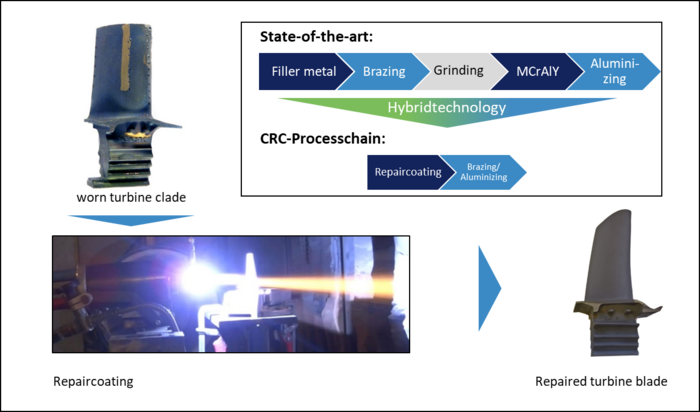

The repair of components in the aviation industry and power plant technology plays an increasingly important role in view of rising raw material and manufacturing costs. Besides welding, high temperature vacuum repair brazing is already established for turbine blades made of nickel-base alloys. The repair brazing of turbine blades involves complex process steps. The worn turbine blade is stripped down to the base material. The filler metal is applied manually in form of pastes, melt spun foils or tapes, which are also nickel-base alloys. After brazing in a high vacuum, the excess filler metal is removed by grinding or milling. Subsequently, the hot gas corrosion protective layer (e.g., NiCoCrAlY) is applied by thermal spraying. After the coating, the turbine blade is subjected to an aluminizing process. NiAl (β-phase) is formed which further increases the hot gas corrosion resistance. The aluminizing process is usually carried out in a pack cementation or in a special aluminizing furnace with a reactive atmosphere, respectively. The state of the art is that a turbine blade can be subjected to approximately 3 to 4 repair cycles.
In this subproject, a repair coating is applied to the turbine blade by thermal spraying, followed by a combined brazing and aluminizing process. This significantly shortens the current repair brazing process chain, resulting in mechanical and technological improvements (e.g., increasing the number of repair cycles to 6-7) and, at the same time, economic benefits of regenerated turbine blades.
Please note that activating the video will result in the transfer of data to the respective provider. Further information can be found in our privacy policy.
Play video
Coating of a turbine blade by atmospheric plasma spraying (APS).
Results
The feasibility of this hybrid technology was successfully demonstrated during the first two funding periods. For this purpose, Inconel 718 flat samples with a nickel-base filler metal (Ni650 = NiCrSi) and the hot gas corrosion protection layer (MCrAlY, with M = Ni and / or cobalt), which represents the repair layer, were coated by thermal spraying and subjected to a common heat treatment in a pack cementation (brazing/aluminizing). Depending on the temperature-time profile, pores or cavities form in the brazed seam. This is due to the infiltration of the molten filler metal into the hot gas corrosion protective layer as well as diffusion and segregation effects. Through an extended heat treatment, a homogeneous microstructure of the repair coating could be adjusted. In order to describe diffusion processes of the existing alloying elements in this repair layer, the aluminium was also applied by thermal spraying, which is a new approach. Starting from the basic material, the following layer system results: Ni650/NiCoCrAlY/aluminium, which is subjected to a common heat treatment (brazing/aluminizing). The coated Inconel 718 samples were heated to different temperatures (500 °C, 660 °C, 900 °C, 1100 °C, 1190 °C). The local composition was determined by EDX analysis. The molar ratios of aluminium and nickel and aluminium and cobalt suggest the formation of possible phases or compounds. According to the phase diagrams Ni-Al and Co-Al, these are the phases NiAl (β-phase), Ni3Al (g'-phase), Ni3Al + Ni, NiAl + Ni and the aluminium-rich phases Al9Co2 and Al3Co. In addition, the element distributions of the alloying elements of the repair coating were determined. It could be shown that the aluminizing can be carried out by a thermally-sprayed aluminium layer. Starting from the base material, the coating system Ni650/MCrAlY /aluminium is applied and subjected to a heat treatment. The successful proof of the feasibility opens up the possibility of integrating the application of the ceramic thermal barrier coating (TBC) into this hybrid technology, since the hot gas corrosion protective layer (MCrAlY) also acts as a bond coat to ceramics.
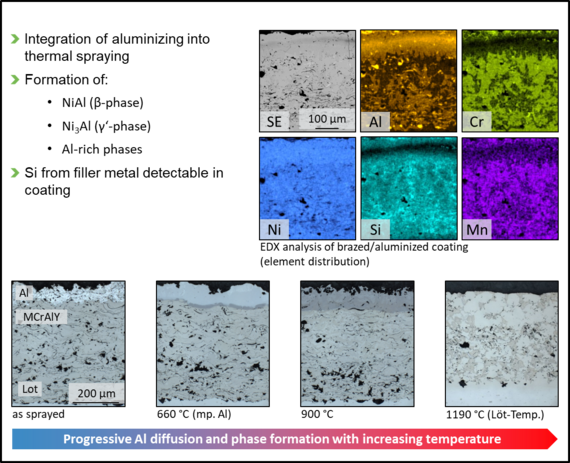
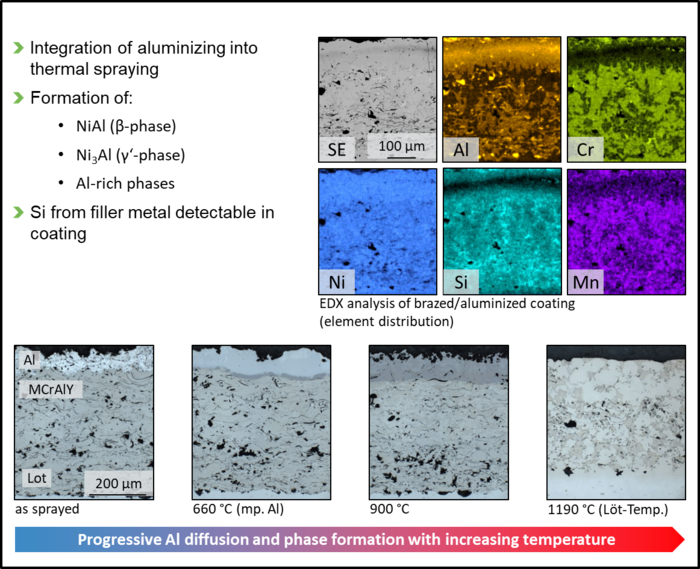
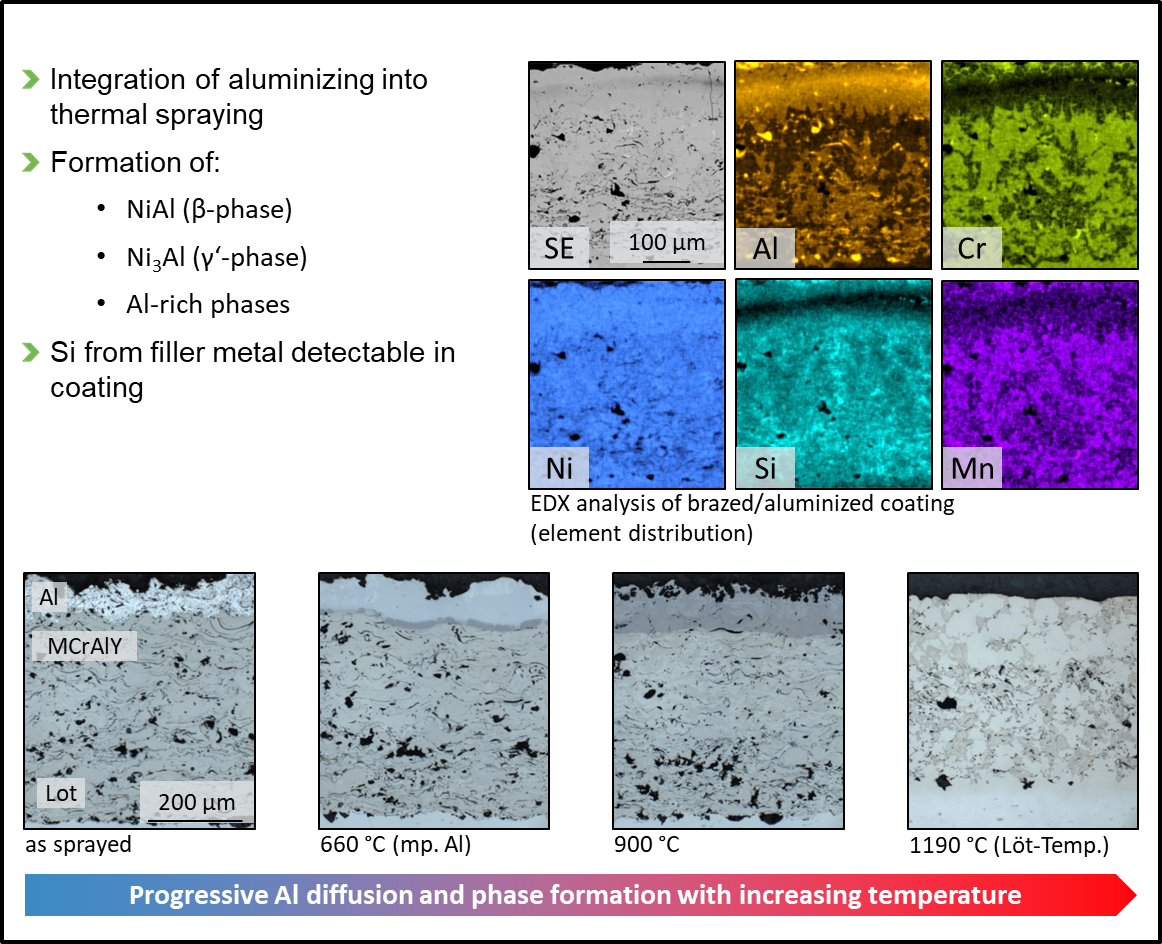
Current research and outlook
In the third funding period, the hybrid process developed in the first two funding periods will be further developed with the results obtained, in view of the regeneration sequence within and between the process cells of the Collaborative Research Centre. From the knowledge gained during the second funding period, the complete repair brazing process (coating and brazing/aluminizing) with regard to the functionality of the entire engine is investigated with regard to the reproducibility and the resulting process reliability. The sensitivity of the process parameters (coating and brazing/aluminizing parameters) on the microstructure after the brazing/aluminizing process by instrumental analysis (EDX and X-ray microscopy) is carried out by design of experiments (DOE). From these results, a statement can be made about the process reliability. These results will be used to extend the brazing/aluminizing process to other aviation related materials such as the single-crystal CMSX-4 alloy, where it is desired to produce a directionally solidified brazed seam. Additionally, the results obtained that the previously discontinuous brazing/aluminizing process in a vacuum furnace can be transferred into a continuous process by a continuous shielding gas furnace whereby the thermal barrier coating is integrated in the hybrid process. The results further shorten of the process chain, which are essential for the selection process with regard to the regeneration sequence within the CRC. The developed hybrid technology can also be transferred to stationary gas turbines in power plants, rolling bearings from wind turbines, rolls and cylinders from printing presses as well as cylinder liners and transmission components from diesel engines.
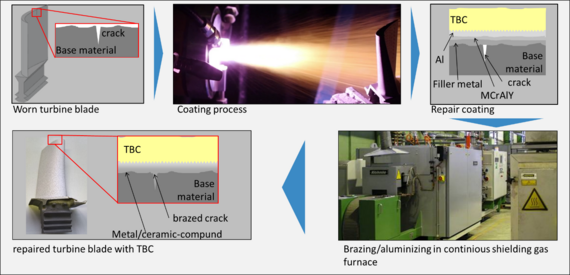
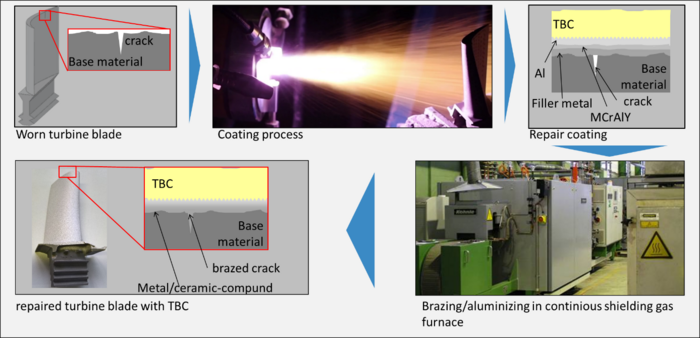
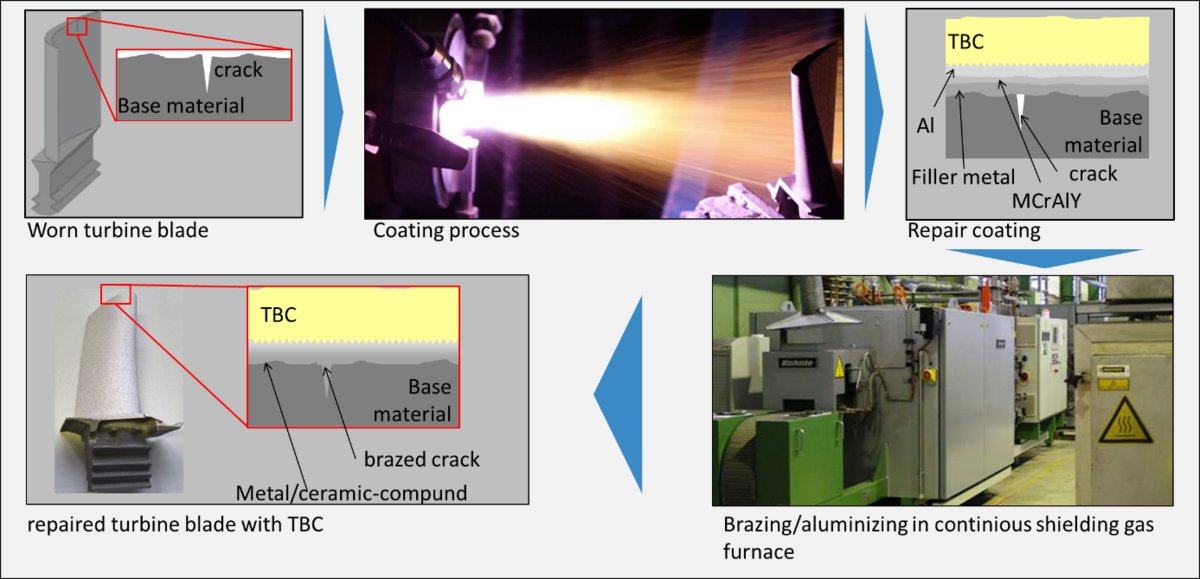
Subproject leader
58453 Witten
58453 Witten
30823 Garbsen
Staff
58453 Witten
58453 Witten
Publications
International Scientific Journal Paper, peer-reviewed
-
(2021): Thermally Sprayed Nickel-Based Repair Coatings for High-Pressure Turbine Blades: Controlling Void Formation during a Combined Brazing and Aluminizing Process, Coatings 11 (6), S. 725
DOI: 10.3390/coatings11060725 -
(2020): Application of a titanium filler metal by cold gas dynamic spraying, Thermal Spray Bulletin 72 (2020) [2] 108 - 113
-
(2017): A Combined Brazing and Aluminizing Process for Repairing Turbine Blades by Thermal Spraying Using the Coating System NiCrSi/NiCoCrAlY/Al, J Therm Spray Tech 9 (1), S. 13
DOI: 10.1007/s11666-017-0612-z -
(2017): Future regeneration processes for high-pressure turbine blades, CEAS Aeronautical Journal 2017 (online)
DOI: 10.1007/s13272-017-0277-9 -
(2015): Combined brazing and alitising process for thermally sprayed Ni-based alloys for the repair of turbine blades, Thermal Spray Bulletin 2015 (8) (2), S. 56–61
-
(2013): Heat treatment of thermal sprayed Ni-base-fillermetal-NiCrAlY-coating systems for repairing turbine blades, Thermal Spray Bulletin 2013 (6) (2), S. 119–123
International Scientific Journal Paper, not peer-reviewed
-
(2014): Heat Treatment of thermally sprayed Ni-based brazing materials NiCrAlY coating systems for the repair of turbine blades, Welding and Cutting 2014 (2), S. 108–111
International Conference Paper, peer-reviewed
-
(2016): Regeneration of high pressure turbine blades. Development of a hybrid brazing and aluminizing process by means of thermal spraying, In: Proceida CIRP. The 5th International Conference on Through-life Engineering Services (TESConf 2016): Elsevier B.V, S. 5.
International Conference Paper, not peer-reviewed
-
(2017): Heat treatment of the thermally sprayed coating system NiCrSi/NiCoCrAlY/Al for repair brazing high pressure turbine blades, In: ITSC 2017. DVS-Berichte, Band: 336. DVS Media GmbH, Düsseldorf, 2017, S. 462-466
-
(2015): Development of a two-stage hybrid technology for repairing turbine blades, Proceedings from the International Thermal Spray Conference and Exposition 2015. ASM International, Materials Park, Ohio, S. 37–40
-
(2015): Future regeneration processes for high pressure turbine blades, 64. Deutscher Luft- und Raumfahrtkongress 2015, 22-24 September 2015. Deutsche Gesellschaft für Luft- und Raumfahrt - Lilienthal-Oberth e.V.®. Rostock, 24.09.2015
-
(2014): Common application of Ni-based fillermetals and hotgascorrosion protection coatings by means of thermal spraying with subsequent heat treatment for near net shape turbineblade repairing, Proceedings / 11th International Conference THE "A" Coatings in Manufacturing Engineering, 1 - 3 October 2014, Thessaloniki, Greece. Thessaloniki: Ed. Ziti, S. 179–184
-
(2012): A New Hybrid Process for Repair Brazing and Coating of Turbine Blades, Thermal Spray 2012: Proceedings from the International Thermal Spray Conference and Exposition. Ohio: ASM International, S. 110–113
-
(2011): Repair Brazing of Turbine Blades using Thermal Spraying, Proceedings. Thessaloniki: Ed. Ziti, S. 347–352
National Conference Paper, not peer-reviewed
-
(2011): Reparaturlöten von Turbinenschaufeln mittels thermischen Spritzens, Tagungsband zum 14. Werkstofftechnisches Kolloquium & 9. Industriefachtagung Oberflächen- und Wärmebehandlungstechnik. Chemnitz: Eigenverlag, S. 231–236
-
(2010): Neue Lösungswege für das Reparaturlöten und -beschichten von Turbinenschaufeln, Neue Fertigungstechnologien in der Luft- und Raumfahrt, Machining Innovations Conference; Tagungsband, 23. und 24. November 2010, Hannover, S. 435–447; Garbsen: PZH, Produktionstechn. Zentrum (Berichte aus dem IFW, 2010,8),




